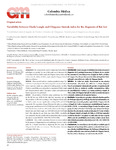Variability between Clarke's angle and Chippaux-Smirak index for the diagnosis of flat feet

Use este enlace para citar
http://hdl.handle.net/2183/30889
Excepto si se señala otra cosa, la licencia del ítem se describe como Creative Commons Attribution 4.0 International License (CC-BY 4.0)
Colecciones
- Investigación (FCS) [1293]
Metadatos
Mostrar el registro completo del ítemTítulo
Variability between Clarke's angle and Chippaux-Smirak index for the diagnosis of flat feetTítulo(s) alternativo(s)
Variabilidad entre el ángulo de Clarke y el índice de Chippaux- Smirak para el diagnóstico de pie planoAutor(es)
Fecha
2017Cita bibliográfica
Gonzalez-Martin C, Pita-Fernandez S, Seoane-Pillado T, Lopez-Calviño B, Pertega-Diaz S, Gil-Guillen V. Variability between Clarke's angle and Chippaux-Smirak index for the diagnosis of flat feet. Colomb Med (Cali). 2017 Mar 30;48(1):25-31.
Resumen
[Abstract] Background: The measurements used in diagnosing biomechanical pathologies vary greatly. The aim of this study was to determine the concordance between Clarke's angle and Chippaux-Smirak index, and to determine the validity of Clarke's angle using the Chippaux-Smirak index as a reference.
Methods: Observational study in a random population sample (n= 1,002) in A Coruña (Spain). After informed patient consent and ethical review approval, a study was conducted of anthropometric variables, Charlson comorbidity score, and podiatric examination (Clarke's angle and Chippaux-Smirak index). Descriptive analysis and multivariate logistic regression were performed.
Results: The prevalence of flat feet, using a podoscope, was 19.0% for the left foot and 18.9% for the right foot, increasing with age. The prevalence of flat feet according to the Chippaux-Smirak index or Clarke's angle increases significantly, reaching 62.0% and 29.7% respectively. The concordance (kappa I) between the indices according to age groups varied between 0.25-0.33 (left foot) and 0.21-0.30 (right foot). The intraclass correlation coefficient (ICC) between the Chippaux-Smirak index and Clarke's angle was -0.445 (left foot) and -0.424 (right foot). After adjusting for age, body mass index (BMI), comorbidity score and gender, the only variable with an independent effect to predict discordance was the BMI (OR= 0.969; 95% CI: 0.940-0.998).
Conclusion: There is little concordance between the indices studied for the purpose of diagnosing foot arch pathologies. In turn, Clarke's angle has a limited sensitivity in diagnosing flat feet, using the Chippaux-Smirak index as a reference. This discordance decreases with higher BMI values. [Resumen] Introducción: Existe una gran variabilidad en las mediciones para el diagnóstico de la patología biomecánica. El objetivo de este estudio fue determinar la concordancia entre el ángulo de Clarke y el índice de Chippaux-Smirak, para determinar la validez del ángulo de Clarke utilizando como referencia el índice de Chippaux-Smirak. Métodos: Se realizó un estudio observacional en una muestra aleatoriamente seleccionada (n= 1,002) en A Coruña (España). Tras el consentimiento informado del paciente y la aprobación del comité de ética, se estudiaron variables, antropométricas, índice de comorbilidad de Charlson y un examen podológico (ángulo de Clarke, índice de Chippaux-Smirak). Se realizó un estudio descriptivo y un análisis multivariado de regresión logística. Resultados: La prevalencia de pie plano utilizando el podoscopio fue de 19.0%(pie izquierdo) y 18.9%(pie derecho), incrementándose con la edad. La prevalencia de pie plano según el índice ChippauxSmirak o el ángulo de Clarke se incrementan considerablemente llegando a 62.0% y 29.7%. La concordancia (kappa I) entre los índices según grupos de edad oscila entre 0.25-0.33 (pie izquierdo) y 0.210.30 (pie derecho). El coeficiente de correlación intraclase (CCI) entre el índice de Chippaux-Smirak y el ángulo de Clarke es -0.445 (pie izquierdo) y 0.424 (pie derecho). Tras ajustar por edad, índice de masa corporal (IMC), score de comorbilidad y sexo la única variable con un efecto independiente para predecir discordancia es el IMC (OR= 0.969; IC 95%: 0.94-0.998). Conclusiones: La concordancia entre los índices estudiados para el diagnóstico de la patología del arco plantar es reducida. Existe a su vez una reducida sensibilidad del ángulo de Clarke para el diagnóstico de pie plano, utilizando como referencia el índice de Chippaux-Smirak. Esta discordancia disminuye con valores más altos de IMC.
Palabras clave
Footprint
Pedigraph
Chippaux-Smirak Index
Clarke’s angle
Flatfoot
Foot
Sensitivity and specificity
Anthropometry
Podiatry
Huella
Pedígrafo
Índice Chippaux-Smirak
Angulo Clarke
Pie plano
Pie
Sensibilidad y especificidad
Antropometría
Podología
Pedigraph
Chippaux-Smirak Index
Clarke’s angle
Flatfoot
Foot
Sensitivity and specificity
Anthropometry
Podiatry
Huella
Pedígrafo
Índice Chippaux-Smirak
Angulo Clarke
Pie plano
Pie
Sensibilidad y especificidad
Antropometría
Podología
Versión del editor
Derechos
Creative Commons Attribution 4.0 International License (CC-BY 4.0)
ISSN
0120-8322






